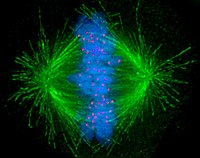
Photo from wikipedia
As one of four filament types, microtubules are a core component of the cytoskeleton and are essential for cell function. Yet how microtubules are nucleated from their building blocks, the… Click to show full abstract
As one of four filament types, microtubules are a core component of the cytoskeleton and are essential for cell function. Yet how microtubules are nucleated from their building blocks, the αβ-tubulin heterodimer, has remained a fundamental open question since the discovery of tubulin 50 years ago. Recent structural studies have shed light on how γ-tubulin and the γ-tubulin complex proteins (GCPs) GCP2 to GCP6 form the γ-tubulin ring complex (γ-TuRC). In parallel, functional and single-molecule studies have informed on how the γ-TuRC nucleates microtubules in real time, how this process is regulated in the cell and how it compares to other modes of nucleation. Another recent surprise has been the identification of a second essential nucleation factor, which turns out to be the well-characterized microtubule polymerase XMAP215 (also known as CKAP5, a homolog of chTOG, Stu2 and Alp14). This discovery helps to explain why the observed nucleation activity of the γ-TuRC in vitro is relatively low. Taken together, research in recent years has afforded important insight into how microtubules are made in the cell and provides a basis for an exciting era in the cytoskeleton field.
Journal Title: Journal of cell science
Year Published: 2021
Link to full text (if available)
Share on Social Media: Sign Up to like & get
recommendations!